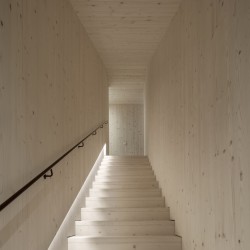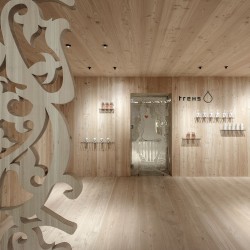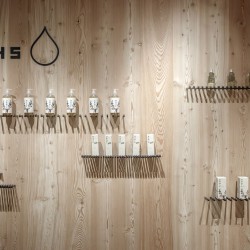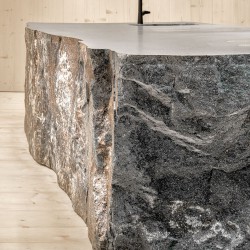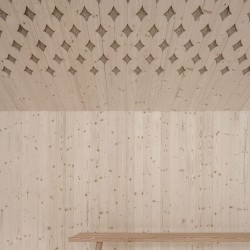Pedevilla Architects . photos: © Gustav Willeit
The “Trehs Haus” is located in the hidden treasure Bad Schörgau, embedded in the nature of the Sarentino Valley. “Trehs” is a symbolic figure for all mountain creatures, sorceresses of the mountain world who were familiar with the forces of nature and were able to help the people of their time.
_
Bad Schörgau – TREHS HAUS
_
The Trehs “world of fragrances” understands itself as a competence centre and includes 4 careproduct lines: Sarner Latsche (Sarentino mountain pine), Acqua vinea nobilis (grape water), Original Bergheu (mountain hay) and Sarner Zirbe (swiss stone pine). The products are created on the basis of local traditions, in close connection of place and people.
The showroom extends as an open space over two floors, the filling with laboratory and warehouse are located in the basement.
The outer shell of the historic town has been preserved (ornamental elements, shutters, etc.) or reconstructed: with the original nineteenth-century pouring table, the historic monk roof tiles have been restored with local porphyry sand. The interior was redesigned with natural spruce and hemp, one of the oldest useful plants on earth. The room should convey a protective character. The ornament creates a connection to the local tradition: simple and yet generous, without frills and yet of a simple, quiet decoration.
·
Bad Schörgau – COOKING ACADEMY
_
The Cooking-Academy is part of the event and seminar area of the wellness and gourment hotel Bad Schörgau and sees itself as a platform to gain an insight into the local gourmet cuisine.
The central element is the big cooking block, a monolith of grey-green local porphyry, almost 5 metres long and with a gross weight of 22,000 kg. Only the countertop as been burnished, the other surfaces show the original breakage of the stone.
The cooking area is connected to a large hall with space for about 100 guests. A spiral staircase leads to the seminar room with a large roof terrace.
The room’s pattern is based on the element of the circle. The circle is the most stable geometrical shape, it conveys security and protection. The overlaps of the circles result in the special ceiling structure due to their star-shaped three-dimensional formulations. The outer facade is based on the same geometric basis, but without the “stars”. The interiors are completely lined with hand-limed spruce and hemp.
·
Bad Schörgau – BADL
_
Bad Schörgau has a centuries-long tradition as a rural bath, embedded in the living culture of the Sarentino mountain farmers. The in-house spring was first mentioned as a healing spring in 1624. The historical Bauernbadl (rural bath), with its bath-tubs, works with water from the mineral spring and the Re-Nature implementation of the Sarantino mountain pine.
The bathroom on the ground floor consists of an entrance area with the consultation and the rooms of the farmer’s bathroom, on the upper floor there are the treatment- and massage-rooms.
The entrance to the bathroom area is through a wall with tendril pattern, which was derived from the historical gable ornament of the original Bauernbadl. The room has been completely lined with domestic larch, on the big wall near to the entrance the products are exhibited on hand-forged nails made of black steel.
A freely curved staircase connects the two floors. The shape of the staircase and the flowing sequences of rooms refer to the theme of water. A relaxation room, lined as a freeform and with arolla pine shingles, completes the offer.
The “building materials” are provided by nature: stone and wood – hard and durable on the one hand, warm and cosy on the other. The local sarentino porphyry stone is used for the production of the floors and plaster surfaces. The domestic larch is used for doors, floors and furnishings. Traditional craftsmanship such as feather keel embroidery (peacock feathers) for the leather doorhandles establishes a direct link to the Sarentino culture. For the washbasins there are especially designed enamel bowls.
_
Client: Bad Schörgau
Location: Sarntal/South Tyrol
Total cubature: 900 m³
Project and realisation: 2016-2017
Photos: Gustav Willeit











